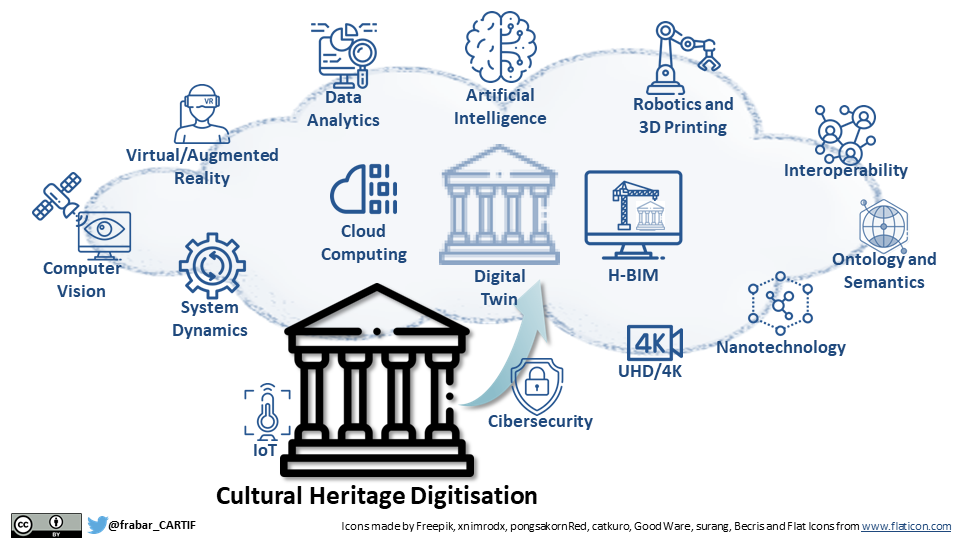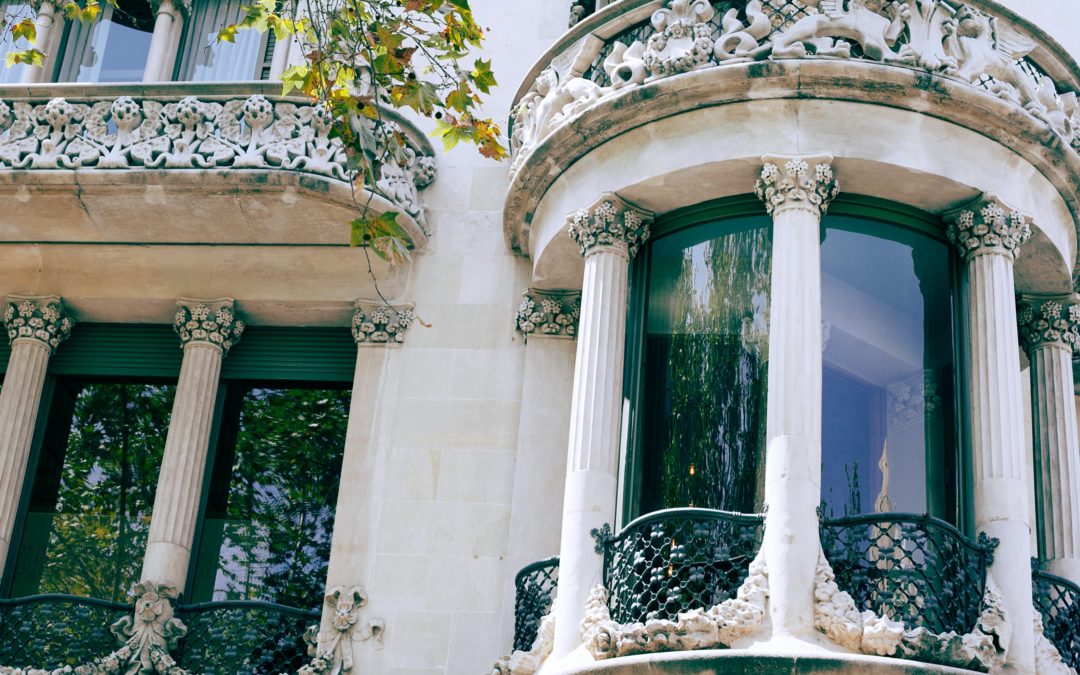The word “Digitization” is ubiquitous today. The term is extremely used but its meaning is worn out when taken to a specific terrain. Answering to how?, with what?, for what?, and even, why? for the particular case of Cultural Heritage it is not an easy taks, nor closed. Digitization and Heritage is a Romeo and Juliet style romance (to make a cultural simile), where the respective families view the matter with suspicion, even when it is destined to be a well-matched marriage, not one of convenience.
Digitization sounds technological, state-of-the-art. Heritage sounds archaic, old-fashioned. Putting one together with the other, and avoiding formal definitions (otherwise non-existent), it is proposed to define digitization in this case as the incorporation of digital technologies (those based on electronics, optics, computing and telecommunications) to the products, processes and services that organizations follow and offer for research, protection, conservation, restoration and dissemination of Cultural Heritage.

Digitization affects the way of facing work, the proper way of working and the organization in itself, modifying its structure and managing. This alteration in the organization schema causes an atavistic fear of losing the artisan and professional-knowledge supported value that features the companies in the Cultural Heritage sector, made up of more than 90% by SMEs in the EU. This is the real reason why they take the longest to “digitize”. It is not just an issue about buying, installing and operating computers, software and wireless networks. The change is deeper: it is not a question of appearance; it is a fundamental question. But it is well worth remembering that the workshops and people who appear in history and arts books today because the works they have bequeathed, are indeed famous for having innovated and used the best technologies available on their time.
But, what are the technologies at stake today for the Digitization of Cultural Heritage? Without being exhaustive, and also being aware of leaving things in the pipeline, the most demanded technologies are summarized below:

Multidimensional modelling and simulation (including Heritage BIM -HBIM[1]-): exact 3D virtual replicas of movable and immovable assets; mechanical, electrical, acoustic, lighting and signal coverage simulations with specialized software; 4D (evolution in time). The HBIM parametric modelling is remarkable to complying with Directive 2014/24/ EU and also to addressing extra dimensions: 5D (costs); 6D (sustainability and energy efficiency); 7D (maintenance).

Sensors, Internet of Things (IoT) and 5G: multipurpose devices for capturing, combining and communicating all kinds of data over the Internet. The 5G allows making between 10 and 20 times faster the traffic of these data compared to current 4G mobile communications. These technologies are typically used in structural and environmental monitoring for condition assessment.

Data analytics to get useful information: cloud computing (to archive all kind of information and making it accessible and searchable from anywhere and from any device connected to the Internet); edge computing (local computing -on the axis-, to improve response times and save bandwidth); big data (massive treatment of structured and unstructured data – in the order of Petabytes: 1015 bytes-). The determination of causes and effects, together with the prediction and characterization of behaviours (including visitor flows) are common examples

Artificial intelligence (AI): machine learning (ability to learn without specific coding) and deep learning (learning based on neural networks that mimic the basic functioning of the human brain) are well-known. One example is the Gigapixel technology to enlarge images to see tiny details thanks to intelligent computer processing of extremely high-quality photographs. Another example is the automatic recognition of symbols or animal species in a prehistoric rock engraving on which a-priori nothing can be distinguished.

Systems dynamics and informational entropy: they are ways of studying adaptive mechanisms in complex and changing systems (such as all those that humans forge -which are precisely characterized by creativity and culture-) to make predictive models or to support decision-making and management.

Computer vision: capturing and processing of images by cameras that operate in one or more spectral ranges to see beyond our eyes also at all scales (from space with COPERNICO satellites, to the microscopic world): search for patterns, detection of pests , humidity, alterations, irregularities and falsifications, definition of authorship and artistic techniques, conservation assessment. Applied to video analytics, it is very effective in guaranteeing the security against theft, vandalism or looting.

Digital twins: combining some (or all) of the previous aspects (multidimensional modelling, simulation, computer vision, sensors, IoT and AI) upon a virtual replica ready to remotely work under a multidisciplinary approach, allows to anticipate possible problems and experiment safely before performing any intervention, helping to its optimal planning. It can be applied to movable assets, but it has special significance in immovable ones.

High-quality audio and video: Hi-Res for audio and FullHD, 2K and 4K for video are words already entered in our lives. They allude to the highest attributes and durability of the audio and video formats that can be used for the registration of intangible heritage or the broad dissemination of heritage in general.

Virtual reality (VR), augmented reality (AR) and mixed reality (XR): to recreate spaces, decorations and configurations, past or future, even to look into planned interventions upon 3D models using special glasses or smartphones.

Ontologies and semantics: to uniquely name and hierarchically structure the constituent elements of movable or immovable assets and cultural landscapes so that they are understandable both by specialists and laymen regardless of their language and cultural background.

Interoperability: to synchronize data, systems and processes nevertheless of their origin and format.

Cybersecurity: to defend against malicious attacks on computers, servers, mobile devices, electronic systems, networks and data. Blockchain allows avoiding falsifications as well as guaranteeing the authorship and the digital visa of projects.

Robotization and 3D printing: configurable robots (adaptable, shippable and remotely-assisted) allow the modular construction of specific elements in-situ. They also allow the automation of inspection, cleaning, assembly, conservation and restoration processes in dangerous or hard-to-reach places, quickly and accurately. It can be combined with 3D printing for sealing, insulating and watermarking in different materials and finishes. Particularly 3D printing allots functional replication (total or partial) at different scales to create prototypes, parts, mock-ups and test series.

Nanotechnology and new advanced materials: the continuously increasing processing power of computers and their combination with the hardware of machinery allows the study and manipulation of matter in incredibly small sizes (typically between 1nm and 100nm), resulting in a wide range of materials and techniques usable in conservation and restoration.
In March 2021, the European Commission published a report that reviews and evaluates the actions and progress achieved in the EU in the implementation of the Recommendation (2011/711/EU) on digitization, online accessibility and digital preservation of cultural heritage as one of the main political instruments in those matters[1]. The ecological and digital transitions are, in fact, the keys to the agreement on the so-called Recovery Plan for Europe[2]. EU Member States have agreed on the need to invest more in improving connectivity and related technologies to strengthen the digital transition and emerge stronger from the COVID-19 pandemic, transforming the economy and creating opportunities and jobs for that Europe into which citizens want to live. During the confinement society has shown that Cultural Heritage in digital format was a true social balm, with museums and collections open online 24 hours a day.
Thus it is the right time and there are no general solutions for “digitization”. Cultural Heritage is not about producing thousands of cars, parts or packaging per day. Quite the contrary: each company, each project, each asset must be considered for what it is: something unique. To make a clear example, imagine somebody getting into the supermarket and asking ‘what is there to eat?’ The answer, consonant with the perplexity, could be: there are from precooked to fresh, meat, fish, eggs, dairy and sweets in all possible varieties. It depends on your culinary tastes, your hunger and the time you have, your nutritional needs, the time of day … In short: particular problems require particular solutions.
[1] https://blog.cartif.es/en/bim-approach/
[2] https://digital-strategy.ec.europa.eu/en/library/european-commission-report-cultural-heritage-digitisation-online-accessibility-and-digital
[3] https://ec.europa.eu/info/strategy/recovery-plan-europe_es
- Artificial Intelligence and Cultural Heritage: A Promising Alliance (With Nuances) - 7 November 2025
- The black gold of Castilla y León: its Cultural Heritage - 5 December 2024
- Talking about everything visible and invisible (II) - 30 August 2024

Very thorough, informative and empowering article! We need to connect in LinkedIn!